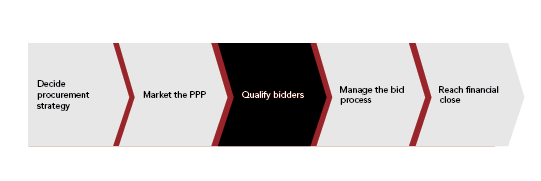Qualifying Bidders

Photo Credit: Image by Pixabay
The next step is often to carry out a bidder pre-qualification process to select the companies and consortia that will be invited to submit proposals. Not all countries select qualified bidders in advance, instead assessing qualifications as part of an open bidding process. The pros and cons the two approaches are described in Deciding the Procurement Strategy. The pre-qualification process consists of preparing and issuing the Request for Qualifications (RFQ)—along with advertising the launch of the tender process, as described in Marketing the PPP—and evaluating the information received to select a group of qualified bidders. The Caribbean PPP Toolkit (Caribbean 2017, Module 5, Section 6.4) discusses qualification criteria. Farquharson et al (Farquharson et al. 2011, 113–120) describes the purpose of pre-qualification, typical types of criteria and processes, and provides brief guidance on project launch. The EPEC Guide to Guidance (EPEC 2011b, 27–28) also provides a helpful overview of the pre-qualification process. For procurements that include a pre-qualification stage, the procurement process is officially launched when the Request for Qualifications (RFQ) is issued. The RFQ typically includes enough information on the project for potential bidders to decide whether they are interested, and information on how the project will be procured. It should also clearly set out the process and requirements for the qualification process. Information on the project at this stage could include an overview of technical and service requirements, key commercial terms (although not typically a draft contract), and a list of the further information that will be made available at the procurement stage. Information on the qualification process typically includes the qualification criteria (see Firm Qualification Criteria), the information required from firms and the format in which that information should be presented, and the timeline and process for evaluation. The following resources describe further the typical content of RFQ documents: The following provide model, or example RFQ documents: Some governments require approval of the RFQ documents, before issuing the procurement notice as described in Marketing the PPP. The procurement notice typically advises companies on how to obtain the RFQ package. Governments may also alert investors directly that the RFQ package is available. Having received statements of qualifications from interested firms, the implementing agency (or the designated evaluation team) must evaluate those qualifications against the pre-defined qualification criteria. Firm Qualification Criteria describes typical firm qualification criteria with resources and examples. These criteria can be defined and applied on a pass/fail basis, or used to rank firms, and qualify a certain number. Once the evaluation is completed, the implementing agency needs to inform qualified firms or consortia, and those that have been unsuccessful. As described in the South Africa PPP Manual procurement module (ZA 2004a, 25), the list of qualified firms is typically published. The agency also needs to make sure it provides sufficient information on the decision to unsuccessful firms. One of the aims of the procurement process is to select a competent firm with the capacity to implement the project. It is important to consider the qualifications of the firms behind each proposal. This can be done through a pre-qualification process to identify bidders, or as part of the first stage of the tender process (sometimes called post qualification). In either case, clear qualification criteria should be established before beginning the procurement process. Firm qualification criteria can be quantitative or qualitative. They typically involve considering the sponsoring firms’ financial robustness, previous experience with similar projects, and the experience of key members of the management team. Careful selection of these criteria is important to avoid excluding firms (for example, smaller firms) that could make good partners; or including firms that are poorly-qualified. The following provide discussion and examples of firm qualification criteria: The Philippines’ Implementing Rules and Regulations under the BOT Law (PH 2006, Section 5.4) describes three categories—legal requirements, experience or track record, and financial capability.
Preparing and issuing the Request for Qualifications
Evaluating the information received to identify qualified bidders
Find in pdf at PPP Reference Guide - PPP Cycle or visit the PPP Online Reference Guide section to find out more.
Updated:
Related Content
INTRODUCTION
Page Specific DisclaimerVisit the PPP Online Reference Guide section to find out more.
PPP BASICS: WHAT AND WHY
Page Specific DisclaimerVisit the PPP Online Reference Guide section to find out more.
Featured Section LinksESTABLISHING THE PPP FRAMEWORK
Page Specific DisclaimerVisit the PPP Online Reference Guide section to find out more.
PPP CYCLE
Page Specific DisclaimerVisit the PPP Online Reference Guide section to find out more.
Identifying PPP Projects
Type of ResourceAppraising Potential PPP Projects
Type of ResourceStructuring PPP Projects
Type of ResourceDesigning PPP Contracts
Type of ResourceManaging PPP Transactions
Type of ResourceManaging PPP Contracts
Type of ResourceDealing with Unsolicited Proposals
Type of ResourceKey References - PPP Cycle
Type of Resource
Additional Resources
Request for Proposals (RfP) in Asset Recycling
Type of ResourceRight Block TitleTABLE OF CONTENTSRight Block DescriptionI. GUIDELINES FOR IMPLEMENTING ASSET RECYCLING
3. Guidelines for Asset Identification
• Request for Qualification (RfQ) in Asset Recycling
• Request for Proposals (RfP) in Asset Recycling
• Managing the Bid Process in Asset Recycling
• Bid Evaluation and Award in Asset Recycling
• Contract Finalisation in Asset Recycling
• Towards Financial Close in Asset Recycling